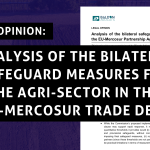With this letter, we express our serious concerns regarding the Certification Framework for Carbon Removals text under consideration for adoption at the Coreper meeting on 17.11.2023.
We believe the current text has significant issues that need addressing before adoption can be considered. As it now stands, it undermines the effectiveness of the EU’s existing climate policies instead of contributing to their achievement.
Our analysis highlights several critical points that we believe require further reconsideration and clarification:
Offsetting of emissions with CRCF certified units: The text makes no effort to prevent that emissions are offset with CRCF certified units. This risks delaying decarbonisation and consequently undermines the effectiveness of the EU’s current climate target. This issue is further exacerbated by many of the activities in the scope leading to vulnerable and temporary storage of carbon (such as soil carbon sequestration), or even avoided emissions. In order to have a positive impact on the atmosphere, carbon removals and sequestration need to be accounted separately and occur additionally to emission reductions, not instead of them.
Double counting between corporate registries/claims and country inventories/targets: The current text endorses double claiming. This presents a grave environmental integrity issue, also leading to greenwashing and misguiding of consumers. Not only offsetting is allowed, but it is allowed twice with the same units. Each CRCF unit should only be used at most once, by one actor – public or private. Private sector support should be sought through contribution models.
Temporarily parked carbon is not carbon removal: The text allows for certification of temporary storage in products, vegetation and soils as removals. These categories are highly problematic, they are vulnerable to reversals as well as to inaccurate accounting and their monitoring is expensive, laborious and unreliable. Activities that are important but do not fit within the definition of carbon removal should be incentivised with different policy tools.
Confusing and inadequate definitions: The definitions provided in the text are imprecise and incomplete, which causes confusion and risks creating challenges in implementation and enforcement. Concepts such as ‘durable’, ‘long-lasting’, ‘several decades’ are imprecise while at the core of the environmental integrity of this file. This is exacerbated by weak language on long-term storage in Article 6.1.
The focus on quantifying carbon farming benefits: Due to the short length of the biogenic carbon cycle, risk of reversals, inaccurate accounting, and difficulties for ensuring additionality, nature based carbon sequestration is better suited to be supported by activity based finance with clear environmental and climate benchmarks rather than carbon credits.
Exclusion of BAU emissions from the formulas: The addition of the word ‘attributable’ to ‘GHG increase’ does not address the fundamental concern that BAU emissions are still ignored during certification. This oversight could result in certifying activities that cause net emissions as delivering net removals on paper, and severely overestimating the environmental benefits of certified activities.
Inclusion of oceans in carbon removals definition: The text’s inclusion of oceans as a storage medium is concerning. Carbon storage projects in open sea risk severe impacts on ecosystems and coastal communities – while monitoring environmental delivery and potential impacts (including beyond the project zone) is extremely challenging. Furthermore, the lack of accountability and clear responsibility in international waters means that addressing impacts and liability for reversals is too challenging for the inclusion of oceans in the scope of this regulation.
Sustainability criteria are too weak: Phrases “shall not significantly harm” and “may generate any co-benefit” do not carry any legal weight or meaning. While art 7.4 is a good addition, it should be expanded to any activity that would increase demand for land and/or biomass, and be aimed at biodiversity protection and ecosystem restoration. Land-based activities must support this critical sustainability objective. Biodiversity protection and enhancing nature’s resilience are also the best route for long term nature based carbon storage and sequestration. In addition, the proposed changes to sustainability objective (f) should be reversed, as they broaden and therefore water down this crucial sustainability objective. Soil health and avoidance of land degradation should be made into a separate sustainability objective.
In light of these concerns, we strongly urge you not to adopt the text in its current form. We believe that achieving a more precise and well-defined regulatory framework is feasible, but rushing the adoption of the current text, in our view, is not wise and carries fundamental risks – not just for the implementation of this file, but to the integrity of and trust in the EU’s climate action.



